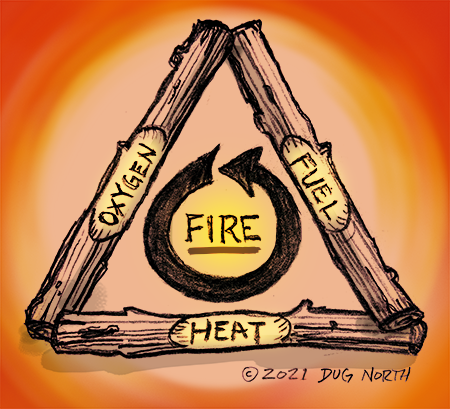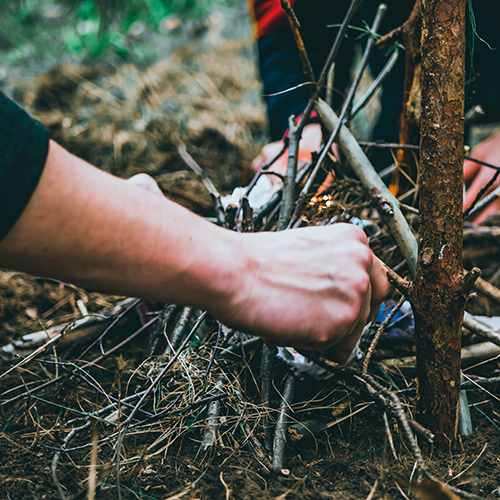Sometimes a match alone won’t start a fire
In Part 1 of this series, we learned about the fire triangle and how heat, oxygen, and fuel are all needed for a fire. Next, let’s take a look at how we can use this knowledge to troubleshoot problems we might encounter when starting an outdoor fire. So, how do you start a campfire and keep a fire going?
Fire problems Associated with Heat
Problems with heat almost always have to do with not having enough of it. This prevents the pyrolysis process from happening. Without those gasses, there is nothing to react with oxygen, and thus prevents combustion.
The fire triangle: heat fuel and oxygen
Fire built on damp ground
A tinder bundle that is lit on damp ground -- or worse, on snow and ice -- will lose much of its heat in attempting to warm and dry the surface below. This may prevent adequate heat from getting to the next largest size of tinder or fuel
Solution: move the fire to a drier location.
Solution 2: build your initial fire on top of some aluminum foil which creates a barrier between the fire and the wet ground.
Solution 3: build up a structure of sticks or tree bark to get the fire off the ground. Dry materials are best.
Sparks can sometimes be too brief
Sparks from ferro rod are too brief
The spark scraped from a ferrocerium rod may be too brief to warm up and ignite your tinder.
Solution: If using a ferrocerium rod, try incorporating some flash tinder. Flash tinders are extremely fine tinders that accept the smallest spark and then burn very hot and fast. This can help spread the initial flame to more of your tinder bundle. Common flash tinders include such as cattail fluff, milkweed fluff, and magnesium shavings.
Pro tip: the ferro rod itself can be used as a type of flash tinder. Slowly and carefully scrape unburned shavings from the rod into your tinder bundle. This requires some patience and care. These ferro rod shavings will ignite within the bundle when you later use the ferro rod to shower the tinder bundle with sparks.
A regular match may not provide enough heat
Flame is too brief
The flame from a match may not last long enough to light small kindling directly.
Solution 1: use finer tinder to allow the match flame to catch hold.
Solution 2: use a bigger match! There are several brands of large matches that burn longer and hotter. Consider the UCO Titan Stormproof Matches, which burn for 25 seconds.
Solution 3: use a flame extender. The flame from a match can be transferred to a small candle, a long sliver of fatwood, or strips of birch bark. This will give you a longer flame that can help you light less-than-perfect tinder.
Pro tip: some conifer tree resins are very flammable. A glob of pine pitch on the end of a stick can make a great flame extender.
Fire problems associated with Oxygen
Problems with oxygen most often take to form of an inadequate access
The Fuel is Limiting Airflow
It can be tempting to put a lot of fuel on a small fire but this can be a problem if it prevents enough air from reaching the system. A fire that isn’t getting enough oxygen will have diminishing flames and often a lot of smoke.
A fire needs good access to oxygen in the air
Solution 1 : Blowing and fanning a fire are well known solutions, but somewhat labor-intensive. Blowing can be made much easier and more efficient by using a small tube such as a pocket bellows directed at the base of the fire.
Solution 2: Consider learning to build a fire lay. A fire lay is an arrangement of fuel into a structure that helps to ensure that adequate air can reach the fire. Common fire lays included the tipi and the log cabin.
Solution 3: If there is a prevailing wind, create a gap in the fuel out on that side of the fire. This creates an opening into which the wind can enter, effectively blowing on the fire for you.
Solution 4: Finally, recall that hot air rises. This means you can dig a trench below the fire to provide air from underneath.
Pro tip: there is a fire lay designed to allow you to adjust the amount of oxygen available to a fire. My friend, The Gray Bearded Green Beret, has a great video demonstrating the elevator fire lay.
Fire problems Associated with Fuel
Damp Wood
The moisture in damp wood robs heat from the fire triangle. The heat energy is wasted in turning water into water vapor. This will delay or prevent the wood from reaching the point of pyrolysis.
A flame source with its own integrated tinder
Solution 1: Look for dry wood. The lower dead limbs of conifers are often dryer than what is on the ground. Look under logs, bark, or trees with a thick canopy. If you have a saw or axe, seek the inner portions of standing dead wood, which is often dryer.
Solution 2: Use a lot more tinder. A very large tinder bundle -- especially one made of birch bark or fatwood, which will burn when wet -- can dry out your kindling and get your fire going.
Solution 3: Use an accelerant to help things along. This could be a natural resource such as pine pitch or a commercial fire starting tinder which typically burn longer and hotter than most natural tinders.
Solution 4: use a flame source that integrates a long-burning tinder. Examples include UCO Sweetfire Fire Starters and UCO Sweetfire Behemoth Fire Starters, both of which burn for many minutes.
Pro tip: once you have a fire going, be sure to use it to dry out any damp or wet firewood.
Fuel Added Too Quickly
Adding too much wood too quickly can stifle a fire that is still being built. This is a combination of problems: not enough air reaching the fire and not enough heat to ignite the excessive amount of fuel.
Solution: only add more fuel, when you see flames extending well above the fuel that is already in the fire.
A dense mix of kindling sizes often works best
The Wood Pieces are Too Large
If the wood is very large, it will be able to absorb a great deal of heat before it breaks down and starts to volitilize gas. This problem may show up as a weak or diminishing flame with the kindling or firewood failing to ignite.
Solution 1: make sure you have a range of kindling sizes mixed together. This mix should include matchstick, pencil, and then magic marker size pieces.
Solution 2: use and axe or knife and baton to split the wood. Dividing in this way the fuel reduces the mass of each piece while also increasing its surface area relative to its volume. This will help any applied heat to start the pyrolysis process.
Fuel is Too Spread Out
It’s a very common mistake to have the tinder or kindling arranged loosely and too spread out. The problem here is that one burning piece of wood isn’t able to effectively heat any adjacent pieces. Said another way, each individual piece of kindling may burn in isolation, failing to support the larger chain reaction of combustion.
Solution: Bringing the pieces of fuel closer together. This allows all of the burning pieces to heat each other, reinforcing the combustion chain reaction.
Fuel Located in the Wrong Spot
Both heat and flames rise. Fuel placed too far to the side of a tinder bundle is unlikely to receive enough heat to ignite.
Solution: place your smallest and most dry tinder directly above your tinder bundle. This may require making some quick adjustments on-the-fly so be ready to act once the tinder bundle is lit.
Resources
UCO Sweetfire Fire Starters
UCO Sweetfire Behemoth Fire Starters
Fatwood
* Some of the links on this page go to Amazon and some go to the website of my friend, Josh Enyart, The Gray Bearded Green Beret. I make a small commission on these referrals, and I appreciate your support!







